Here are some notes to myself
And here is a page about me and my shorthand (myshorthand.html)
And here is the version of Gregg shorthand I chose. (whichgregg.html)
And in case I am incorrect or I miss something you can email me at salkilldn@yahoo.co.uk (not that I promise to reply!)
Names, dates, pictures etc are all wrong.
| Timothy Bright |
1588 |
Characterie
Even considering its earliest publication it is the worst system ever.
536 words to be memorised with no regular relationship to the word except for its first character.
Each of these first characters are unique and are suffixed by one of 12 endings.
The first character can be rotated [90 degrees anticlockwise, 45 degrees clockwise, 45 degrees anticlockwise] to produce 4 forms for each.
So in total there could be up to 4*12 words formed from that starting letter.
So with the 18 letters of the alphabet we could have 4*12*18=864 using this set: but as I say there are only 536 used in Bright's table.
On the right is what can be deduced from the table (letter "A" cannot be read from my electronic print of the one extant copy in the Bodliean).
The other picture is an excerpt from the table showing how irregularly the characters relate to the latter letters of the word they represent.
The majority of the book consists of a dictionary of English words with no shorthand assigned.
How the 536 in the table can be used to represent those shown (or any others) I do not, yet, know. |
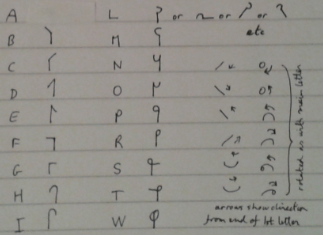 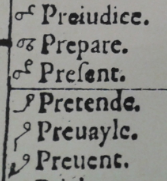 |
| John Willis |
1602 |
... Art of Stenograpy |
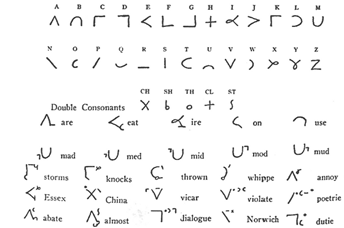
Thanks to Wikipedia |
| Thomas Shelton |
1600-1650 |
Tachygraphy. Pepys. I've a facsilmile book |

Thanks to http://collation.folger.edu/2012/05/thomas-sheltons-shorthand-version-of-the-lords-prayer |
| Jeremiah Rich |
1654 |
'composed by William Cartwright, published by his nephew, Jeremiah Rich'
I've a facsilmile book
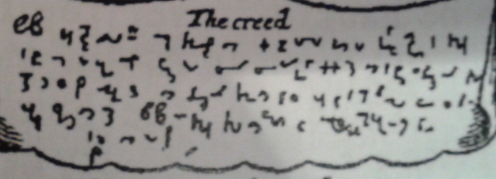
|
|
| William Mason |
1672–1709 |
published Arts Advancement in 1682
Pen plucked from an Eagles Wing 1672
http://en.wikisource.org/wiki/Mason,_William_%28fl.1672-1709%29_%28DNB00%29 |
|
| John Byrom |
1720 |
|

Thanks to Rider University's digitisation of Leslie's Shorthand collection |
| Samuel Taylor |
1786 |
"similar to Byrom" |

Samuel Taylor 1801, from Rider University's digitised books. |
| Thomas Gurney |
mid 1700s |
Brachygraphy. (Based on Mason) Parliament's Gurney girls I've an original 10th edition |
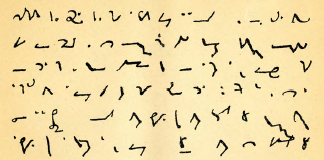
Miller's 1884 Gurney's System (Improved), from Rider University's digitised books. |
| Andrew Graham |
1857 |
|

Thanks to "Eclectic shorthand by cross.png" from Wikipedia |
| Duploye |
1860 |
Gregg particularly influenced by this.I've an original 14th Sloan-Duployan edition (?1880) |
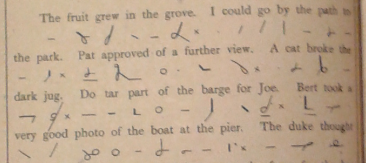 Sloan-Duployan Sloan-Duployan |
|
|
|
 |
possibly http://en.wikipedia.org/wiki/List_of_shorthand_systems
picture http://en.wikipedia.org/wiki/File:Eclectic_shorthand_by_cross.png
&
another picture
this is good, and more than what I was aiming at http://www.t-script.co.uk/systems.php
Incredible. Louis A. Leslie, great man and collector. Full credit to credit to Rider University for digitisation!
http://cdm16471.contentdm.oclc.org/cdm/landingpage/collection/p15457coll1
Malone[1885] angered Gregg[1888] http://www.encyclopedia.com/doc/1G2-3404707808.html
After reading Sloan I see where Gregg got the idea of reversing circles to represent "r". Also perhaps the concept of looped circles.
Strangely, now I look at the Gurney system, despite its oddities, and the seemingly frequent occurrence of obtuse angled joinings, it does look rather good.
It is very horizontal which I like. It looks similar to Shelton's but less fiddley - and certainly with less irregular short forms. It seems very British.
These are just pdf files
(quiz.pdf)
(quiz_answer.pdf)
(U_S_states.pdf)









 Sloan-Duployan
Sloan-Duployan